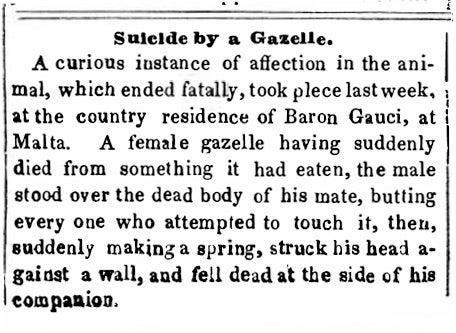This article was published in Scientific American’s former blog network and reflects the views of the author, not necessarily those of Scientific American
Gazelles have polygynous mating habits. Usually, males will mate with many different females throughout their lifetimes. Yet, this short article from the August 14, 1847, Scientific American suggests a monogamous bond between gazelle that was so strong it produced a tragic ending:

On supporting science journalism
If you're enjoying this article, consider supporting our award-winning journalism by subscribing. By purchasing a subscription you are helping to ensure the future of impactful stories about the discoveries and ideas shaping our world today.
While the article suggests grief to be the culprit of the male gazelle’s suicide, it seems improbable unless their captive lifestyle led to a monogamous relationship. Perhaps the male gazelle also ate whatever made the female expire, and it caused some neurological damage, making him harmful to himself and others. It is certainly hard to deduce from the information in the article. We do know that the male gazelle suddenly sprang forward into a wall. Whether intentional or not, this action seems like the same one performed by gazelles when they are pursued by a predator, known as “stotting,” or jumping into the air with all four legs simultaneously off the ground. Here’s an example:
If this were the case, it is likely that what seemed a suicide may have been the male gazelle’s unfortunately timed response to perceived human predators. However, the romantic in me wants to read this as a Romeo and Juliet situation, and I imagine that immediately after the male gazelle took his own life, the female woke up (not fatally poisoned by what she—in this case—intentionally ate), saw her beloved’s lifeless body, and stotted into the same wall.
While the article probably does not refer to star-crossed gazelle lovers, I’m curious to know if there was any chance this was an actual suicide, and further, whether there is any proof that animals take their own lives. Any animal experts out there care to weigh in?